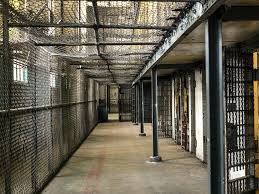![]()
State and federal prison populations dropped in 2016, the Bureau of Justice Statistics (BJS) announced Wednesday, making three successive years of decline in the national incarceration rate.
This decline led to the lowest rate of imprisonment (measured as commitment to a prison for more than one year) since 1997, when the rate was 450 prisoners per 100,000 U.S. population. The 2016 rate was 444 per 100,000.
There were an estimated 21,200 fewer prisoners in state and federal prisons in 2016 as compared against 2015, the BJS reported. Decline in the federal prison population, overseen by the Bureau of Prisons, was responsible for approximately 34 percent of the 2016 drop.
Prison admissions also declined between 2016 and 2015, by 2,300 people. The federal system was responsible for the overwhelming share—2,200 fewer admissions—of that decline.
The decline in prison population held across black, Hispanic, and white inmates.
“The rate of imprisonment decreased 4 percent for black adults (from 1,670 to 1,608 per 100,000), 2 percent for white adults (from 281 to 274 per 100,000) and 1 percent for adult Hispanic prisoners (from 862 to 856 per 100,000),” the BJS reported.
There are significant differences between the makeup of federal and state prison populations. Federal inmates are a small proportion of the overall prisoner population: according to the Prison Policy Initiative, federal prisoners were just nine percent of the incarcerated population (including prisons and jails) in 2016.
According to the BJS’s data, the majority (54 percent) of state-level offenders were incarcerated for violent offenses, as of 2016. Federal offenders were primarily incarcerated for drug-related offenses. Those drug offenses were “more than 99 percent” for trafficking.
There was also a notably high concentration of non-citizens among federal offenders: 21 percent at year-end 2016, not counting those detained by the Department of Homeland Security. A recent DHS report found that 94 percent of confirmed non-citizens in federal custody were unlawfully present in the United States.
The overall pattern of decline is part of a noteworthy reversal of trend that began under President Barack Obama. The federal prison population fell five percent between 2009 and 2015, according to a Pew Research analysis, the first time there had been such a decline since Jimmy Carter.
State and federal prison populations grew enormously between the Carter and Obama presidencies, driven by policies responding to America’s crime rates, which increased steadily between the late 1960s and early 1990s. Even after crime rates hit their peak in 1993 and began to decline, incarceration increased. By 2015, the United States had the highest rate of incarceration on earth.
There is disagreement as to the efficacy of America’s carceral regime. Proponents argue that the rise of incarceration was critical to curbing violent crime, while critics attack it as needless and racist in its impact. Some research, including a 2012 Berkeley study, suggests a declining marginal impact of imprisonment on the crime rate, meaning that incarceration’s effectiveness at reducing crime may decline over time.
It remains unclear how the new Trump administration, with its greater rhetorical focus on “law and order,” will affect the prison population. Attorney General Jeff Sessions has already made severalmoves to reverse Obama-era loosening of charging policies related to marijuana and low-level drug offenses. However, such offenders make up a vanishingly small proportion of those currently incarcerated.





